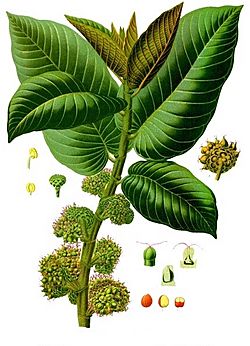Moraceae facts for kids
Quick facts for kids Moraceae |
|
|---|---|
 |
|
| Panama Rubber Tree (Castilla elastica) | |
| Scientific classification | |
| Kingdom: | |
| Phylum: | |
| Class: | |
| Order: | |
| Family: |
Moraceae
(Dumort., 1829) Gaudich., in Trinius, 1835, nom. cons.
|
| Genera | |
|
See text. |
|
The Moraceae family is often called the mulberry family or fig family. It is a group of flowering plants with about 40 different types of genera and over 1000 species. This amazing family includes many well-known plants. You might recognize the fig, banyan, breadfruit, and mulberry trees. The osage-orange tree is also part of this group.
Contents
Where Do Moraceae Plants Grow?
Most plants in the Moraceae family love warm weather. They are usually found in tropical and subtropical areas around the world. You can find them in places like South America, Africa, and Asia. Some types also grow in warmer parts of North America. They thrive in forests and open areas.
Cool Facts About Moraceae
Many plants in the Moraceae family are trees or shrubs. Some are vines or even herbs. A special feature of many Moraceae plants is their milky sap. This sap is called latex. It can be seen if you break a leaf or stem.
These plants are very important to people and animals. They provide food, wood, and other useful products. For example, figs and mulberries are tasty fruits. The wood from some trees is used for building.
Famous Members of the Family
Let's look at some cool examples from the Moraceae family:
- Figs: There are many types of figs, like the common fig. They are known for their unique "fruit." This fruit is actually a special structure. Tiny flowers grow inside it.
- Mulberries: These trees grow delicious berries. Silkworms love to eat mulberry leaves. This makes mulberries important for silk production.
- Breadfruit: This large, starchy fruit is a main food source in many Pacific islands. It can be cooked in many ways.
- Banyan Trees: These are famous for their aerial roots. These roots grow down from the branches. They can form new trunks. A single banyan tree can spread over a huge area.
- Osage Orange: This tree has thorny branches. It produces large, bumpy, green fruits. These fruits look like oranges but are not eaten by humans. Its strong wood was used by Native Americans for bows.
How Moraceae Plants Reproduce
Moraceae plants reproduce using flowers and seeds. Their flowers are usually small. They are often grouped together in special ways. For example, fig flowers are hidden inside the fig structure. Pollination often happens with the help of insects. For figs, tiny wasps help with pollination. After pollination, the flowers develop into fruits. These fruits contain the seeds. The seeds then spread to grow new plants.
Images for kids
-
Ficus retusa (Moraceae) in Bagh-e-Jinnah, Lahore
See also
 In Spanish: Moráceas para niños
In Spanish: Moráceas para niños


